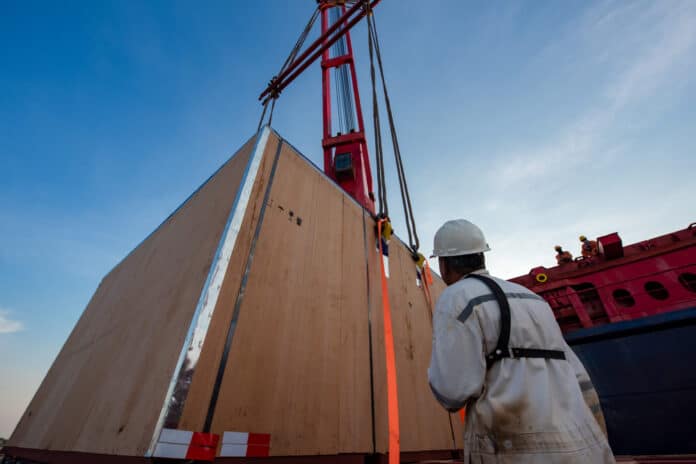Project logistics takes place successfully all over the world everyday thanks to a mix of experienced personnel, intense coordination, planning, and savvy use of logistics technology. Project logistics is a very complex field and covers many great aspects.
Simply put, Project logistics is the transportation processes of cargo with characteristics such as large, heavy, bulky, out-of-gauge, unusually shaped, high-value and critical items. The cargo is generally part of an infrastructure project, that requires specialized stowage, lifting capacity, transporting, loading, and discharging at different ports. This type of cargo requires special care handling requirements depending on the cargo sizes, center of gravity, lifting points, cargo footprint and support, distribution load, availability of cargo handling equipment, and installation requirement at the final project site.
What are the most important aspects of project logistics?
Project logistics involves planning, organizing, managing, processing, and controlling the complete flow of goods, materials, and information associated with the successful completion of a specific project. The freight involved is typically large, bulk, heavy, unusually shaped, and high value, making project logistics one of the most demanding areas of the supply chain, logistics, and transportation.
1. Planning
Planning of project cargo logistics movements requires an integrated planning approach that considers the delivery cost management, global logistics processes, end-to-end visibility, transport routing management, both international and domestic workflows, regulations and compliance and financial supply chain management. This approach provides the key components in project logistics and the integration promotes the efficiency of the end-to-end logistics.
2. Characteristics of Project Logistics
Characteristics of project logistics generally start at the feasibility study stage of a project. This entails accessibility to the site, in terms of transport routes, rail-carrying capacities and bridge widths – all of which can dictate the design approach to be followed. In a situation where very long lead-times for equipment apply, it may have to be ordered before completion of the final design. It is this early involvement of supply chain professionals in a project which makes for successful project logistics.
3. The Particular Situation
Consider this situation: Project shipping several 200-ton oversized transformers from Italy and setting them on pads at the project site in Quebec City, Canada successfully. This was accomplished because the team had the right experience to handle this project seamlessly. The transformers were to move from the manufacturer in Italy, trucked to the port of Genoa and shipped to the U.S. Port of Baltimore. From Baltimore, the transformers had to be transshipped to another vessel discharging in Halifax, where they would be loaded onto railcars destined for Quebec City, Canada. Once they arrived at the Quebec City railyard, the transformers were to be loaded to Self-Propelled Trailers (SPT) and transported to the project site about 10 miles away, using a jack-and-slide system. This system is a horizontal load-handling method that involves hydraulic cylinders pushing (or pulling) shoes that carry a load over a controlled friction surface.
However, before the work started, a feasibility study was conducted in Italy for and in Canada to assess the technical capabilities, capacity, calculation of time and cost indicators, and a legal, operational and risk analysis for road transport and rail capacity transport. The feasibility analysis determines the viability of the project. A well-structured and executed feasibility analysis will provide a clear history of the project plan and execution.
4. Location
Another important aspect of project logistics is the selection of the port’s location to achieve the minimum transport cost, which is subject to ocean carriers and suppliers. Distances and accessibility from waterfront infrastructure to project sites are the primary determinants for selecting the carriers and terminals. These technical aspects influence the decisions for marine transport, vessel selection and the handling processes at the ports.
5. Scope of Work
The key to project logistics is understanding the scope of work and the accuracy of the precise plan that will set out for all the contractors to work safely together in a time-critical manner. However, every project is unique, and every project site is different.
6. Personnel/People
Project logistics is a very complex field and covers a great many aspects and one cannot underestimate the role of the Project Logistics Manager. Apart from making sure that the cargo is available when required, the responsibilities of the Project Logistics Manager are crucial to the success of the project. The Project Logistics Manager coordinates the project schedules, supervises the proper transportation of goods, identifies risks, ensures compliance with all laws, regulations and best practices for safety and environmental concerns, develops contingency and mitigation plans, manages the day-to-day operations of the project and coordinates with suppliers, contractors, and stakeholders.
In conclusion, Project logistics requires the integration of all sectors from the company.
This includes all stakeholders, vendors, contractors, and logistics players. Also, commercial, technical and safety must be considered as part of the integrated multidisciplinary planning. The technical and safety evaluation is a priority to ensure safe delivery without any damage to the cargo by selecting the optimal marine transport, land transport, proper port infrastructure and personnel involved in loading and discharging oversized cargo. Project logistics is vital to every large and complex project and before embarking on a project, it should be given enough time and attention to ensure the success of the project.




